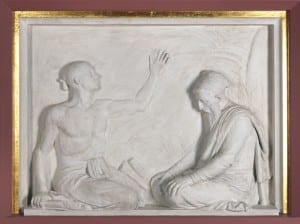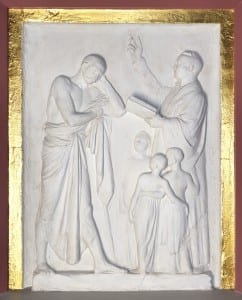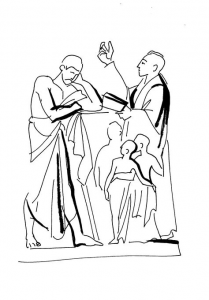Bringing plaster sculptures to life
By Jenny M Wedgbury, on 29 July 2015
One of our volunteers, Agata Matusielanska, MA in Cultural Heritage Studies at University College London, writes about her experience of working on the Flaxman app over the summer.
As a volunteer at UCL Art Museum I’ve recently been working on uploading information into the new Flaxman app, which highlights the work of artist John Flaxman (1755 – 1826) in the Art Museum’s collection. The main place you can see Flaxman’s work is in the Flaxman Gallery, a space in the Main Library. The gallery is probably best known to students as a place to have a lunch or ring friends during periods of studying crisises. Probably not many of them pay attention to the amazing 39 plasters displayed on the wall. UCL Art Museum contains the world’s largest single holding of Flaxman material. The subjects of the plaster casts in the Flaxman Gallery vary from studies for memorials and monuments to bible scenes.
If you haven’t yet I strongly recommend you take a closer look at, for example, the main sculpture located in the middle of the gallery – ‘St Michael Overcoming Satan’. In my opinion it is the most realistic and disturbing piece because it depicts a violent struggle between the forces of good and evil, especially considering its location.
The biggest challenge of my time at UCL Art Museum was how to make somebody like Flaxman interesting enough so the museum’s visitors would be willing to read more about him and be encouraged to visit his gallery it the main library. As I was informed by the UCL Art Museum’ team, and later found out on my own, the artist at the first sight does not appear to be the most interesting artist of his time…we were all wrong however. After a bit of research, I came across information about his time spent in Italy, the commission to create a monument to Lord Nelson’s and the eventful friendships with many artists of his time.
My favourite plaster, after a month of looking at them, is ‘Collins the Poet Contemplating The Holy Bible. Monument to William Collins’. It is the monument to Flaxman’s friend who, according to verses on his tomb, suffered from madness in his final years in the 1750s. During this time the poet spent time in Chichester Cathedral in despair, finding solace only in the bible. The figure looks surprisingly similar to many of the students spending long hours in the UCL library, minus the comfortable slippers he’s wearing…

A Brahmin and a Mohammedan in Earnest Converse for their Country’s Good. Monument to Major-General Sir Barry Close, Bart, 1815.
The second plaster worth mentioning is ‘A Brahmin and a Mohammedan in Earnest Converse for their Country’s Good. Monument to Major-General Sir Barry Close’ from 1815′. This plaster speaks to a time of British colonial power and refers to the military and diplomatic career of Major General Sir Barry Close. The scene depicts the uniting of native Hindu and Muslim leaders under the British East India Company. The sadness on the face of the leader on the right, possibly Hindu, raises questions about the ‘uniting’ aspect of the event. Putting politics aside, the details of the figures’ exotic outfits make it a piece definitely worth a closer look!
The most interesting part of my work was matching the original plasters with drawing made by artist Nelly Dimitranova in 2012. The already familiar to me plasters suddenly appeared as a cartoon-like sketches. I could not help thinking what the neoclassic John Flaxman would think of these new appropriations of his designs.
My volunteering experience at UCL Art Museums has definitely been a rewarding one. The app I worked on will give visitors an insight into Flaxman’s life and art. It will enable them to see the thematic and conceptual links between the plasters, the studies for the models located in the UCL Art Museum and Nelly Dimitranova’s drawings. It will also be a new way for younger visitors to be engaged…because who doesn’t like to play with touchpads, right?
Agata Matusielanska
MA in Cultural Heritage Studies at University College London
 Close
Close







